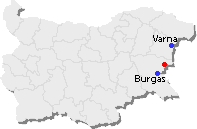
Nessebar is one of the most ancient towns in Europe. The Greek Oykust who came from Megara ahead of numerous colonizers was the one who found that town and named it Mesembria. The town became one of the two major towns in the Pirgos Gulf and kept that status during entire Antiquity. Because of the struggles for domination waged against Apollonia , Mesembria couldn’t establish its own colonies in the Pirgos Gulf and had to lead her colonizers towards the inland of Trakiya (Thrace) by founding the town of Aetos (nowadays Aytos) and as per some historians, also the town of Diamopolis (nowadays Yambol). Even more – Apollonia managed completely to block the access of the Mesembrians to the Black Sea Coast by building her town-colonies Anhialo (nowadays Pomorie) and Pirgos (nowadays Burgas). That period of inner struggles ended with the occupation of the region by the Romans.
During the whole Antiquity, the Roman and the following Byzantine times the town of Nessebar has developed and enriched. We can still witness the signs of the rich old Nessebar today, despite the dark ages it has lived through.
The Bulgarian kings from The Fist and The Seacond Bulgarian Kingdom granted the town wide autonomy and never interfered directly with its policy and trade. The town had oligarchic and democratic government until it became part of The Third Bulgarian Kingdom. In 1925 part of the Greeks living in Nessebar left the town and moved to the village of Bugariovo , now in province Central Macedonia in Greece. They gave new name to the village Nea Mesimbria (New Nessebar).
Nessebar was recognized as an architectural and archeological reserve in 1956, and in 1983 the cultural monuments in the town were included in the list of UNESCO as a part of the world cultural heritage.
The Municipality of Nessebar is the biggest agglomeration on the Bulgarian Black Sea Coast.






















